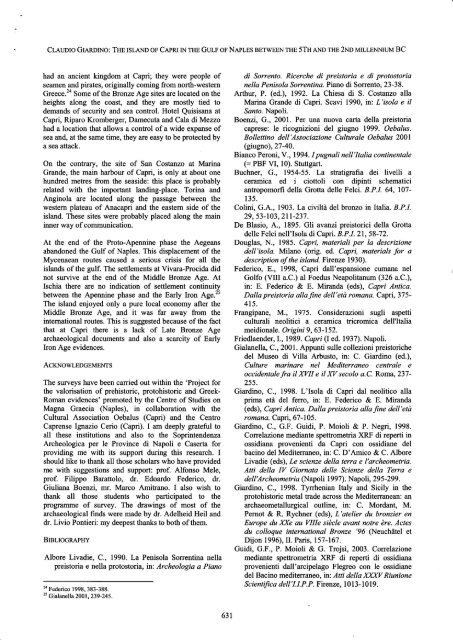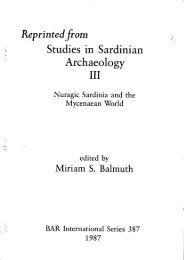The Island of Capri in the Gulf of - Claudio Giardino
The Island of Capri in the Gulf of - Claudio Giardino
The Island of Capri in the Gulf of - Claudio Giardino
Create successful ePaper yourself
Turn your PDF publications into a flip-book with our unique Google optimized e-Paper software.
Creunro GnnorNo: TUB TsLAND on Capm N THE Gwn or NaplBS BETwEEN rsB 5Tn AND THE 2No uIr,lsuNIutvt BC<br />
had an ancient k<strong>in</strong>gdom at <strong>Capri</strong>; <strong>the</strong>y were people <strong>of</strong> di Sorrento. Ricerche di preistoria e di protostoria<br />
seamen and pirates, orig<strong>in</strong>ally com<strong>in</strong>g from north-western nella Penisola Sorrent<strong>in</strong>a. Piano di Sorrento,23-38.<br />
Greece.2a Some <strong>of</strong> <strong>the</strong> Bronze Age sites are located on <strong>the</strong> Arthur, P. (ed.), 1992. La Chiesa di S. Costanzo alla<br />
heights along <strong>the</strong> coast, and <strong>the</strong>y are mostly tied to Mar<strong>in</strong>a Grande di <strong>Capri</strong>. Scavi 1990, <strong>in</strong>:. L'isola e il<br />
demands <strong>of</strong> security and sea control. Hotel Quisisana at Santo. Napoli.<br />
<strong>Capri</strong>, Riparo Kromberger, Damecuta and Cala di Mezzo Boenzi, G., 2001. Per una nuova carta della preistoria<br />
had a location that allows a control <strong>of</strong> a wide expanse <strong>of</strong> caprese: le ricognizioni del giugno 1999. Oebalus.<br />
sea and, at <strong>the</strong> same time, <strong>the</strong>y are easy to be protected by Bollett<strong>in</strong>o dell'Associazione Culturale Oebalus 2001<br />
a sea attack. (giugno), 27-40.<br />
On <strong>the</strong> contrary, <strong>the</strong> site <strong>of</strong> San Costanzo at Mar<strong>in</strong>a<br />
Grande, <strong>the</strong> ma<strong>in</strong> harbour <strong>of</strong> <strong>Capri</strong>, is only at about one<br />
hundred metres from <strong>the</strong> seaside: this place is probably<br />
related with <strong>the</strong> important land<strong>in</strong>g-place. Tor<strong>in</strong>a and<br />
Ang<strong>in</strong>ola are located along <strong>the</strong> passage between <strong>the</strong><br />
western plateau <strong>of</strong> Anacapri and <strong>the</strong> eastern side <strong>of</strong> <strong>the</strong><br />
island. <strong>The</strong>se sites were probably placed along <strong>the</strong> ma<strong>in</strong><br />
<strong>in</strong>ner way <strong>of</strong> communication.<br />
At <strong>the</strong> end <strong>of</strong> <strong>the</strong> Proto-Apenn<strong>in</strong>e phase <strong>the</strong> Aegeans<br />
abandoned <strong>the</strong> <strong>Gulf</strong> <strong>of</strong> Naples. This displacement <strong>of</strong> <strong>the</strong><br />
Mycenaean routes caused a serious crisis for all <strong>the</strong><br />
islands <strong>of</strong> <strong>the</strong> gulf. <strong>The</strong> settlements at Vivara-Procida did<br />
not survive at <strong>the</strong> end <strong>of</strong> <strong>the</strong> Middle Bronze Age. At<br />
Ischia <strong>the</strong>re are no <strong>in</strong>dication <strong>of</strong> settlement cont<strong>in</strong>uity<br />
between <strong>the</strong> Apenn<strong>in</strong>e phase and <strong>the</strong> Early Iron Age.2s<br />
<strong>The</strong> island enjoyed only a pure local economy after <strong>the</strong><br />
Middle Bronze Ag., and it was far away from <strong>the</strong><br />
<strong>in</strong>ternational routes. This is suggested because <strong>of</strong> <strong>the</strong> fact<br />
that at <strong>Capri</strong> <strong>the</strong>re is a lack <strong>of</strong> Late Bronze Age<br />
archaeological documents and also a scarcity <strong>of</strong> Early<br />
Iron Age evidences.<br />
AcTNowTEDcEMENTS<br />
<strong>The</strong> surveys have been carried out with<strong>in</strong> <strong>the</strong> 'Project for<br />
<strong>the</strong> valorisation <strong>of</strong> prehistoric, protohistoric and Greek-<br />
Roman evidences' promoted by <strong>the</strong> Centre <strong>of</strong> Studies on<br />
Magna Graecia (Naples), <strong>in</strong> collaboration with <strong>the</strong><br />
Cultural Association Oebalus (<strong>Capri</strong>) and <strong>the</strong> Centro<br />
Caprense lgnazio Cerio (<strong>Capri</strong>). I am deeply grateful to<br />
all <strong>the</strong>se <strong>in</strong>stitutions and also to <strong>the</strong> Sopr<strong>in</strong>tendenza<br />
Archeologica per le Prov<strong>in</strong>ce di Napoli e Caserta for<br />
provid<strong>in</strong>g me with its support dur<strong>in</strong>g this research. I<br />
should like to thank all those scholars who have provided<br />
me with suggestions and support: pr<strong>of</strong>. Alfonso Mele,<br />
pr<strong>of</strong>. Filippo Barattolo, dÍ. Edoardo Federico, dr.<br />
Giuliana Boenzi, mr. Marco Amitrano. I also wish to<br />
thank all those students who participated to <strong>the</strong><br />
prograÍnme <strong>of</strong> survey. <strong>The</strong> draw<strong>in</strong>gs <strong>of</strong> most <strong>of</strong> <strong>the</strong><br />
archaeological f<strong>in</strong>ds were made by dr. Adelheid Heil and<br />
dr. Livio Pontieri: my deepest thanks to both <strong>of</strong> <strong>the</strong>m.<br />
BrsttocRAPHy<br />
Bianco Peroni, V ., 1994. I pugnali nell'Italia cont<strong>in</strong>entale<br />
(= PBF VI, 10). Stuttgart.<br />
Buchner, G., 1954-55. La stratigrafia dei livelli a<br />
ceramica ed i ciottoli con dip<strong>in</strong>ti schematici<br />
antropomorfï della Grotta delle Felcí. B.P.I. 64, 107-<br />
135.<br />
Col<strong>in</strong>i, G.A., 1903. La civiltà del bronzo <strong>in</strong> Italia. B.PJ.<br />
29,53-103,211-237.<br />
De Blasio, A., 1895. Gli avanzi preistorici della Grotta<br />
delle Felci nell'Isola di <strong>Capri</strong>. 8.P.1.21,58-72.<br />
Douglas, N., 1985. <strong>Capri</strong>, materiali per Ia descrizione<br />
dell'isola. Milano (orig. ed. <strong>Capri</strong>, materials ío, o<br />
description <strong>of</strong> <strong>the</strong> island. Firenze 1930).<br />
Federico, E., 1998, <strong>Capri</strong> dall'espansione cumana nel<br />
Golfo (VIII a.C.) al Foedus Neapolitanum (326 a.C.),<br />
<strong>in</strong>: E. Federico & E. Miranda (eds), Copri Antica.<br />
Dalla preistoria allaf<strong>in</strong>e dell'età romana. <strong>Capri</strong>,375-<br />
415.<br />
Frangipane, M., I975. Considerazioni sugli aspetti<br />
culturali neolitici a ceramica tricromica dell'Italia<br />
meidional e. Orig<strong>in</strong>i 9, 63 -152.<br />
Friedlaender, I., 1989. <strong>Capri</strong> (I ed. 1937). Napoli.<br />
Gialanella, C., 2001. Appunti sulle collezioni preistoriche<br />
del Museo di Villa Arbusto, <strong>in</strong>: C. Giard<strong>in</strong>o (ed.),<br />
Culture mar<strong>in</strong>are nel Mediterraneo centrale e<br />
occidentalefra il XWI e il XV secolo a.C. Roma,237-<br />
25s.<br />
Giard<strong>in</strong>o, C., 1998. L'Isola di <strong>Capri</strong> dal neolitico alla<br />
prima età del ferro, <strong>in</strong>: E. Federico & E. Miranda<br />
(eds), <strong>Capri</strong> Antica. Dalla preistoria alla f<strong>in</strong>e dell'età<br />
romana. <strong>Capri</strong>, 67-105.<br />
Giard<strong>in</strong>o, C., G.F. Guidi, P. Moioli & P. Negri, 1998.<br />
Correlazione mediante spettrometria XRF di reperti <strong>in</strong><br />
ossidiana provenienti da <strong>Capri</strong> con ossidiane del<br />
bac<strong>in</strong>o del Mediterïaneo, <strong>in</strong>: C. D'Amico & C. Albore<br />
Livadie (eds), Le scienze della terra e l'archeometria.<br />
Atti della IV Giornata delle Scienze della Terra e<br />
dell' Archeometria (Napoli 1997 ). Napoli, 29 5 -299 .<br />
Giard<strong>in</strong>o, C., 1998. Tyrrhenian Italy and Sicily <strong>in</strong> úe<br />
protohistoric metal trade across <strong>the</strong> Meditenanean: an<br />
archaeometallurgical outl<strong>in</strong>e, <strong>in</strong>: C. Mordant, M.<br />
Pernot & R. Rychner (eds), L'atelier du bronzier en<br />
Europe du We au VIIIe siècle avant notre ère. Actes<br />
du colloque <strong>in</strong>ternational Bronze 9ó (Neuchâtel et<br />
Dijon 1996), II. Paris, 157-167.<br />
Guidi, G.F., P. Moioli & G. Trojsi, 2003. Correlazione<br />
Albore Livadie, C., 1990. La Penisola Sorrent<strong>in</strong>a nella mediante spettrometria XRF di reperti di ossidiana<br />
preistoria e nella protostoria, <strong>in</strong>: Archeologia a Piano provenienti dall'arcipelago Flegreo con le ossidiane<br />
2a Federico 1998, 383-388.<br />
25 Gialanella 2001, 239-245.<br />
63r<br />
del Bac<strong>in</strong>o mediterraneo, rn: Atti della WV Riunione<br />
Scientifica dell'IJ.P.P. Firenze, I 0 I 3- 10 19.



